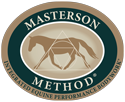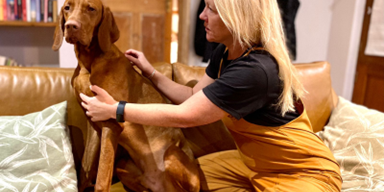By Charlie Frost
Last winter, I lost my 11-year-old dog Harry to cancer. Harry was my first dog, and from the moment he arrived in my family’s life, we adored him. Harry was a Hungarian Vizsla, or ‘Velcro Vizsla’ as they’re aptly nicknamed due to the way they ‘attach’ themselves to their owners, and Harry personified this, following us around like an ever-present, rust-coloured shadow. We embraced this; he ran up mountains with my husband, cantered alongside me and my horse, swam with us in the ocean, camped alongside us in tents and was our constant road-trip companion. He was wherever we were. Until he wasn’t.
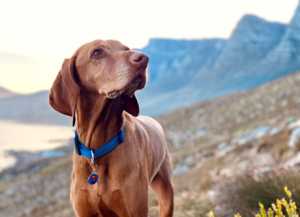
Harry on Table Mountain, Cape Town, South Africa, 2023
When Harry started showing signs of discomfort—instead of running to the door when my husband put on his running shoes, he’d run for his basket—a trip to the vet uncovered arthritis in his spine, and so we slowed things down.
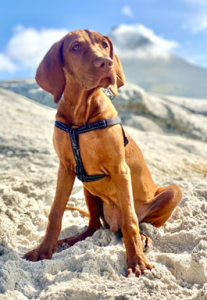
And just two months later, another trip to the vet, showed Hemangiosarcoma—a form of cancer, aptly named ‘the silent killer’ which grows and spreads rapidly. We brought Harry home in disbelief, determined to make his remaining time with us count, but 4 days later he was gone. Suddenly the house felt empty, walking was pointless, and I felt an overwhelming sense of guilt that I hadn’t done more for him. My rust-coloured shadow was replaced by a blanket of loss.
So, we did what many people do whilst trying to navigate the loss of a beloved pet and fill the hole they leave…. We got another Vizsla named Scout.
Scout, Cape Town, South Africa, 2024
A different kind of dog
Scout was everything Harry wasn’t—which was understandable given he was an excitable puppy and in a new home with strange people around him. My grief and guilt, which I foolishly thought would disappear if I had something else to focus on, became worse. Not only did I feel like I’d somehow betrayed Harry, but I couldn’t connect with Scout. I spent the first few months trying to work out how to love and understand this dog in the same way I had with Harry.
Around this time I got the opportunity to attend The Masterson Method® Read and Release online canine bodywork course. It’s a form of bodywork, originally created for horses, that follows and uses the responses of the animal to your touch, to find and release tension. More importantly to me, in addition to the physical benefits, it’s also key in developing the relationship and bond of trust that develops through hands-on connection, something I knew I needed to find with Scout.
As a Masterson Method Fieldwork student, I was already familiar with the equine techniques and seen firsthand the positive effects it has on both horses, and on me personally, so I was hoping to see if The Masterson Method could help me bond with Scout.
I was also curious as to how the techniques could work on a different species, particularly when we know that horses as prey animals have different motivations and behavioral responses. But as Jim Masterson, who created The Masterson Method, explains in his Beyond Dog Massage Book (2023), “both horses and dogs are survival animals who have evolved to block out physical tension and pain to make it through life. It’s just that horses accumulate tension in the body when running away from something, and dogs accumulate tension when running toward something,” which made sense.
Whilst Scout was young and physically healthy, that didn’t mean that he too wasn’t blocking out or hiding tension, which I found out can be caused in dogs by any number of things such as:
- Play and overplay or overexertion (typical for younger dogs and particularly my boisterous boy!)
- Work and overwork
- Compensation for other issues such as joint or ligament or systemic issues
- Past accidents or injuries
- Fear or trust issues – particularly in rescues where we may not know their previous history
Building a relationship with Scout
So it became that every Monday evening for a month, I joined a small group of dog owners from different parts of the globe, for an interactive online course where we’d learn to recognize and use the visual responses of our dogs to our touch to find and release tension, all under the instruction of a qualified trainer, Stef Watts.
There was a mixed bag of canine massage ‘students’ including Tucker, an Australian Shepherd whose owner hoped to certify him as a therapy dog; Jack, a Golden Retriever with hip issues; Pheeny, a rescue who was reactive to other dogs; and Mac, a 90-pound Pitbull/Lab mix who was a de-escalation guard dog, recovering from TPLO surgery. But despite our dog’s differences, we as owners all had the same goal—to improve the lives of our beloved dogs, and to build our connection with them.
Working with a younger, active dog came with its challenges and initially I found it difficult to keep Scout focused (or even awake), but by watching the instructor demonstrate the techniques, observing the other students and their dogs, and practicing the techniques I’d learnt in my own time, I was able to understand Scout’s responses and reactions.
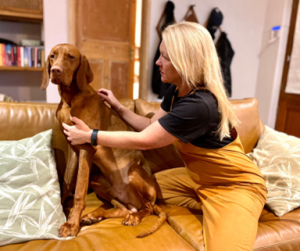
Charlie practicing the techniques at home, 2024
Reducing tension through touch
It became routine for me to start using the techniques I’d learnt on the course during the day, and particularly after a walk when Scout was calmer. In the evenings, when he would come and sit next to me, I would practice doing the Bladder Meridian technique, running my fingers from the top of his head, along his back, down his leg, to the outside of his toe, and watch how he’d respond to this. I’d use the Search, Response, Stay, Release (SRSR) technique, which involves very lightly running my fingers slowly over a specific area, like his sternum or pelvis, and watching for a response, or change in behavior. Once I saw this, I’d lightly keep my fingers on that spot until I got a release, usually in the form of a yawn. I noticed if I did this around Scout’s pectorals or hip joints, he’d yawn and lie-down or get a wonderful sleepy-eyed look about him.
I’ve started to apply the techniques out of home too—when Scout was chased and scared by another dog, I used the Bladder Meridian to help him relax. And I plan on using this particular technique when he goes to the vet; something Harry hated but I didn’t have the tools to help him with.
Scout also loves chasing and carrying a ball or pine cone around, which I now know can cause tension in the jaw and TMJ, with some dogs even going on to develop arthritic issues here. Now, I’ll use some light touch around this area until he gives some sort of release like a yawn or big lick and chew.
And as Scout gets older and starts to run the trails around home, I’ll focus on routine bodywork to help keep his neck and shoulders free from tension, as well as reducing tightness in his hind end. I’m confident I’ve now got the tools in place to recognise, and help with, any restrictions he might have.
But the biggest ‘Aha’ moment for me was learning to trust and connect with Scout, which has had a marked difference in our relationship and how we respond to each other. Walking off the lead has become easier as we feel more ‘in tune’. He’s a more relaxed, calmer and most importantly, a happier dog, and I in turn am more relaxed around him. Gone is the tension that I had because I feel I’ve finally been able to bond with him and once again, I’m feeling the comfort of my ever present rust-coloured shadow.

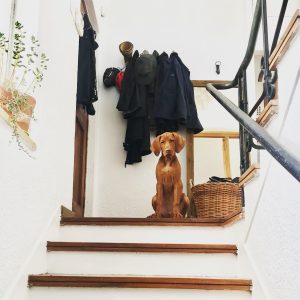
Harry and Scout, 2023 & 2024
For more information on The Masterson Method visit https://mastersonmethod.com/
To see the Masterson Method Canine Massage Courses visit https://mastersonmethod.com/beyond-dog-massage-read-and-release/
To learn more about The Masterson Method for Dogs visit https://www.youtube.com/watch?v=Eeq5GhOQXAI
Immerse yourself in The Masterson Method® of equine bodywork with the Beyond Horse Massage book and/or DVD/Online Streaming you will find in the Masterson Method Store. Looking for a hands-on experience? Explore Masterson Method® Courses and find a Seminar near you here Masterson Method Courses. Unleash your potential and deepen your bond with horses!
